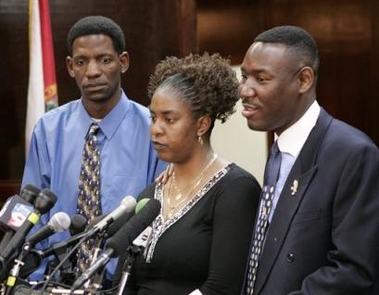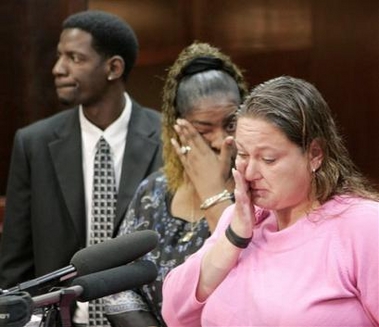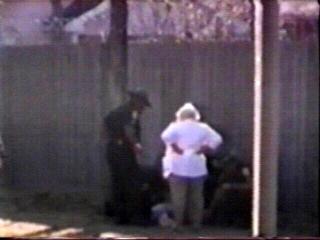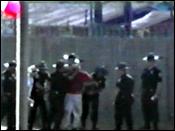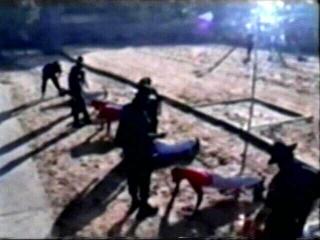WSWS : Arts Review : Film Reviews
United 93: Everything but how and why it happened
By Joanne Laurier
12 May 2006
Use this version to print Send this link by email Email the author
United 93, written and directed by Paul Greengrass
The extremely limited merit of United 93, the account of the hijacked airliner that crashed in a Pennsylvania field on September 11, 2001, lies more in what it doesn’t do than in what it does. The film is not a flag-waving epic. It does not exploit the doomed passengers, refashioning ordinary people responding to a dire situation into heroes driven to save the White House or the Capitol building. Nor does it simply dehumanize the terrorist hijackers, guilty as they were of an atrocious, anti-human crime.
Drawing from interviews with more than 100 family members and friends of the passengers and crew of the ill-fated flight, the carefully (but evasively) crafted film at least has made less likely future recreations of a more distorted, super-patriotic nature.
The film’s British director, Paul Greengrass, is best known for his 2002 docudrama, Bloody Sunday, about the 1972 shooting of 13 unarmed civil rights demonstrators by British soldiers in Londonderry, Northern Ireland. He also directed The Murder of Stephen Lawrence, a 1999 television film exposing police racism and brutality. But what happened to his socially critical views when he turned to the 9/11 events?
United 93 begins on the morning of September 11 by introducing us to the hijackers, all young men, preparing for their part in a deadly mission whose objective is the commandeering of one of four commercial planes to be directed at major American targets. They are crusaders in a holy war.
As passengers on Flight 93 assemble at the gate, the four men sit among their soon-to-be victims. What are they thinking? Products of a toxic political and cultural environment, one assumes that they feel no compassion for those among whom they plan to die. How else could they carry out their plan? This is one of the few genuinely thoughtful or dramatic moments in the film. The would-be terrorists blend unobtrusively into the crowd of passengers except for their air of palpable discomfort, as they pray under their breath to fortify their resolve.
The United Airlines flight is delayed on the ground by airport congestion, leaving the hijackers out of sync with their comrades in the other jets. Once in the air, normalcy prevails, the activities of the flight crew, the cross-conversation among passengers, etc. The hijackers wait and, presumably, steel themselves.
Ultimately, scenes of mayhem on board the plane, as the four men—including one trained to fly the jet—seize control, alternate with disorganized activity at the Air Traffic Control Center in Herndon, Virginia, regional air traffic control stations and NORAD (North American Aerospace Defense Command) headquarters in Rome, New York.
The interplay between the Herndon command center and the military reveals, at best, a gross incompetence that leads to a 40-minute gap between the crash of American Airlines Flight 11 into the World Trade Center and the launching of fighters from Langley Air Force Base in Virginia. Both command centers hear the first reports of the airplanes crashing into the World Trade Center and follow events via cable television news.
Even as United Airlines Flight 175 and American Airlines Flight 77 turn up off-course and presumably hijacked, military commanders are unable to contact the president or vice president for authorization to use force against civilian aircraft. (Michael Moore’s Fahrenheit 9/11 famously shows Bush sitting paralyzed in an elementary school classroom in Florida for seven minutes after being informed about the World Trade Center attack.)
As word spreads among the passengers and crew aboard United 93 about the terrible events in New York City and Washington, they guess at their fate. With nothing to lose, they ultimately storm the cockpit and overwhelm the hysterical terrorists as the plane goes down. An epilogue states that it was not until four minutes after the jet crashed in rural Pennsylvania that military commanders were notified that Flight 93 had been hijacked.
While a few critics take United 93 to task for its portrayal of the terrorists—the San Francisco Chronicle claims that the men do not “deserve the dignity of being humanized in art”—commentators and reviewers, both liberal and right-wing, praise the film as a ‘taut’ and ‘tasteful’ work. Right-wing columnist George Will of the Washington Post goes so far as to proclaim viewing United 93 a civic duty. Director Greengrass was interviewed by extreme-right blowhard and radio host Rush Limbaugh. In part, Will and Limbaugh are clutching at straws within a political environment that is turning against them, but nonetheless Greengrass has provided them with a certain opening, to his serious discredit.
United 93, the first major film to deal with any aspect of September 11, circumvents every contentious issue. Its focus is narrow—recounting, documentary-style, the 90-minute ordeal.
Greengrass has created a work that can satisfy a wide spectrum of opinions. Far too wide a spectrum. Its openness to interpretation is not a strength. The film seems tailored to avoid offending official public opinion. In the movie’s production notes, the filmmaker demurs: “There are lots of ways to find meaning in the events of 9/11 ... I believe that sometimes, if you look clearly and unflinchingly at a single event, you can find in its shape something much larger than the event itself—the DNA of our times ... Hence a film about United 93.”
But Greengrass has not taken a ‘clear and unflinching’ look at his subject matter. How is it to be explained that the Limbaughs and Wills (could there be a worse fate for a filmmaker than to be fêted by that foul crowd?) interpret his work as meshing comfortably with the Bush agenda. One’s views of the film depend largely on what one already knows about that terrible day. Reproducing surface reality, even painstakingly, does not yield something “much larger than the event itself,” and with United 93, Greengrass has not excavated more truth than he put into the project.
The manner in which Greengrass treats September 11, omitting any reference to the process by which the tragic event came to pass, does not qualify as a discovery of the ‘DNA of our times.’ How is it that these young men are able to destroy themselves and others so barbarically? This is never probed, nor is the bizarre conduct of the administration and the military.
The film fails to treat the 9/11 events in a serious artistic manner. The filmmaker’s refusal to provide a broader, historical context for the events inevitably results in a superficial treatment of characters. Powerful characterizations emerge from historical circumstance. The director takes shortcuts, looking for types who will stand in for all that is not developed. So, to avoid stereotyping the lead terrorist as simply a monster, Greengrass casts a soulful-looking performer (Lewis Alsamari) in the role, who, one frankly feels, could not have carried out such a brutal act. So much more socio-historical understanding and depth would have had to go into the appropriate treatment of the hijackers.
A ‘clear and unflinching’ look at 9/11 would inevitably allude to Washington’s decades-long sponsorship of Islamic fundamentalism, underscoring the fact that the hijackers of Flight 93 were not even born when the US began courting and encouraging reactionary Islamicism, first to weaken left-wing and secular nationalist forces in the Middle East and later in Afghanistan to undermine the Soviet Union.
Even within the film’s ‘docudrama’ framework, this would have been feasible. Greengrass places titles at the end of the film, commenting on various facets of the 9/11 events. Why could he not have similarly begun his film with titles conveying the fact, for example, that in 1979 the US commenced giving financial and military backing to the Islamic fundamentalists engaged in guerrilla warfare against the Soviet-backed regime in Kabul? Or why not a title indicating that Osama bin Laden was essentially on the CIA payroll in the early 1980s, through Pakistani intelligence? Why not a reference to the 500,000 Iraqis who died as a result of US-led sanctions or Washington’s unstinting support for the suppression of the Palestinians? Why not a title explaining that on August 6, 2001, George W. Bush’s daily intelligence briefing was entitled “Bin Laden determined to strike in US”? What questions such an approach would have raised in the spectator’s mind!
Greengrass has made it a guiding principle to offer no explanation and no background—none whatsoever!—to a world-historical event that provided the justification for two neo-colonial wars and the deaths of tens or hundreds of thousands. Artists of another day would have found such an approach unthinkable. Disasters of far less geopolitical consequence, like the sinking of the Titanic, were treated more seriously decades ago. Insofar as the film implies a cause or source of the violence, it lies in some inexplicable or perhaps eternal religious fanaticism, the bankrupt argument of right-wingers such as Christopher Hitchens.
Considering the isssues covered in United 93, it is worth noting that Greengrass co-wrote the screenplay for Omagh (2004), a film about a family whose only son is killed in a 1998 terrorist bombing in Northern Ireland. That work reveals that the authorities had been alerted and, in fact, allowed the bombing to take place. In a brief comment on the WSWS two years ago, the film’s devastating implications for the September 11 attacks were noted. In other words, Greengrass ought to be familiar with the workings and machinations of Western intelligence services. Confronted with even more explosive historical material in United 93, however, the director-writer has largely evaded his artistic and intellectual responsibilities.
Nearly five years have elapsed since September 11, 2001 and it is well established that at least several of the future hijackers were known to US government agencies, including the CIA and military intelligence, yet nothing was done to disrupt their operations. The most plausible explanation is that powerful forces within the US military/intelligence complex felt a terrorist incident on American soil would help shift public opinion, permitting the ruling elite to embark on a long-planned campaign of military intervention in Central Asia and the Middle East, as well as attacks on democratic rights at home. Whether or not the authorities could have known the scale of the impending attacks and what the precise targets or damage would be, they acted in such a manner as to prevent the apprehension of known terrorist operatives, thus permitting them to carry out their plot.
United 93 avoids even hinting at the unmentionable, that the Bush administration was aware of the possibility of a terrorist hijacking and ‘stood down’ its military and intelligence apparatus. At most the film suggests that the military was inept.
Greengrass’ artistic evasiveness has produced a film that is subject to almost any interpretation, including one that claims the post-9/11 world necessitates the prosecution of a one-size-fits-all-evils “war on terror,” a euphemism for the pursuit of American global domination.
“That final image haunts me—a physical struggle for the controls of a gasoline-fueled 21st century flying machine between a band of suicidal religious fanatics and a group of innocents drawn at random amongst us all ... I think of it often. It’s really, in a way, the struggle for our world today,” muses the director. Yes, as the film demonstrates, these are haunting images. But how different is this ahistorical clash-of-cultures outlook from that of the pro-war media? In the most neutral—and politically forgiving—of interpretations, United 93 hardly differs, in its final portions, from conventional thrillers and disaster films.
Greengrass subscribes to the notion that “you can’t sustain events like 9/11 without responding on some level militarily, otherwise democracy ceases to function, as one of the primary functions of the state is to protect us all.” The ultra-rightist Limbaugh agrees. He introduced Greengrass to his radio show by informing the audience that the director “suggests that we need a ‘consensus’ in coming up with ideas on how we’re going to ultimately defeat terrorism.”
Despite Greengrass’ shameful cozying up to the right-wing, United 93 has faced reprisals. Alsamari, the Iraqi-born, British actor who plays the lead hijacker, was denied a visa by the US government to attend the film’s New York City premiere.
The problem is Greengrass would not understand, or would not choose to understand, the bitter irony of this exclusion.





